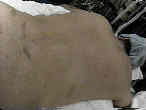
- See:
- Congenital Pseudarthrosis
- Sarcoma Menu
- Neurofibromatosis Foundation
- Discussion:
- neurofibroma is a benign tumor of neural origin;
- has an autosomal dominant trait w/ variable penetrance & high rate of spontaneous mutation;
- it is the most common single gene disorder (1 in 3000);
- presentation:
- neurofibromas are most commonly found in skin and subQ tissue or associated w/ nerve fibers;
- tumors may be solitary or multiple (multiple neurofibromas are most common);
- may affect patients of any age;
- most neurofibromas present as an active stage 2 tumors, but aggresive stage 3 infiltratrive forms
may be seen occasionally;
- biopsy: look for wavy collagenous matrix with elongated cells;
- long standing neurofibromatosis may undergo malignant transformation to neurosarcoma, which is
often heralded by a new onset neurologic deficit;
- ref: Images in Clinical Medicine. Segmental Neurofibromatosis
- diff dx:
- fibrous dysplasia:
- proteus syndrome:
- a disorder characterized by congenital hamartomas;
- hemihypertrophy, partial gigantism of hands or feet, skin nevi, subcutaneous tumors, and skull hyperostosis;
- no cafe-au-lait spots and no neurofibromas are encountered;
- disorder may stem from abnormal growth hormone metabolism;
- ref: Musculoskeletal manifestations of Proteus syndrome: report of two cases with literature review.
- Associated Anomalies:
- cervical spine kyphosis;
- scoliosis:
- congenital psuedarthrosis of clavicle; 

- pseudoarthrosis of extremities:
- congenital psuedarthrosis of tibia: (anterolateral bowing)
- pseudoarthrosis of radius:
- gigantism of the limb:
- erosive defects from contiguous tumors;
- multiple fibrous cortical defects;
- subperiosteal calcifying hematoma;
- MRI:
- demonstrates an oval, avascular tumor;
- neurofibroma is frequently seen as a fusiform mass in continuity w/ major nerve best demonstrated by MRI;
- Histology:
- loose, spindle cell stroma containing wavy eosinophilic fibrillar material;
- verocay bodies may be seen;
- composed of amorphorous eosinophilic material that is surrounded by spindle shaped or oval cells;
- Treatment:
- congenital psuedarthrosis of tibia: (anterolateral bowing)
- ref: Congenital pseudarthrosis of the leg. Late results.
- excision of neurofibroma:
- some neurofibromas infiltrate a peripheral nerve, thereby precluding en bloc extra capsular marginal excision w/o
damaging the nerve
- references:
- ref: Benign nerve tumours of the hand (excluding wrist)
- spine:
- scoliosis:
- references:
Pitfalls of spinal deformities associated with neurofibromatosis in children.
Scoliosis surgery in neurofibromatosis.
Cervical spine abnormalities in neurofibromatosis.
Spine deformity in neurofibromatosis. A review of one hundred and two patients.
Neurofibromatosis of the cervical spine. A report of eight cases.
Pathophysiology of spinal deformities in neurofibromatosis. An analysis of 71 who had curves associated with dystrophic changes.
Neurofibromatous scoliosis. Natural history and results of treatment in thirty-seven cases.
The orthopedic manifestation of neurofibromatosis. A clinical experience and review of the literature.

